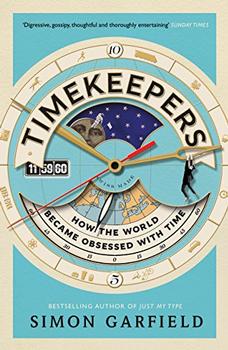Summary | Excerpt | Reviews | Beyond the Book | Readalikes | Genres & Themes | Author Bio

Critics' Opinion:
Readers' Opinion:
First Published:
Jan 2018, 368 pages
Paperback:
Dec 2018, 368 pages
 Book Reviewed by:
Book Reviewed by:
Rory L. Aronsky
Buy This Book
The train wasn't like the computer: its early champions knew fairly well what they were unleashing on the world. Proposing the idea of the Liverpool and Manchester line to prospective backers and nervous crowds in the late-1820s (people thought their lungs would collapse, that cows would fail to milk, that the countryside would be set alight), the line's secretary and treasurer Henry Booth spoke of how the passenger journey time between the cities, previously only possible by horse-drawn coach over turnpike roads, would be cut in half. 'The man of business in Manchester will breakfast at home,' Booth predicted, 'proceed to Liverpool by the railway, transact his business, and return to Manchester before dinner.' (In 1830, dinner was at lunchtime.) Booth, a man who should be more remembered than he is, foretold the impact of the railway far more eloquently than the Stephensons or Brunel. The railway, he correctly suggested, changed 'our value of time'. 'Our amended estimate of the occupation of an hour, or a day' would affect 'the duration of life itself'. Or, as Victor Hugo would later claim, 'All the armies in the world are not so powerful as an idea whose time has come.'
The Liverpool and Manchester railway was the biggest mechanized engineering project the world had seen. It was, of course, at that time also the fastest railway in the world, covering the 31 miles in around 2 hours and 25 minutes. Within a few years of its opening there were accidents all over the country, but also a huge sense of industrial adventure and release: the destiny of the world's economies was now hurtling on iron wheels, and the minute-hand had found its vital and indispensible purpose.
British steam engines were being shipped throughout the world. In February 1832 a new publication called the American Rail-Road Journal carried news of a rail alongside the Erie and Hudson canal, and plans for imminent openings in New Jersey, Massachusetts, Pennsylvania and Virginia. Passenger railways opened in France in 1832, Ireland in 1834, Germany and Belgium in 1835, and Cuba in 1837. In 1846 the whole of Britain was being dug up or drilled through or laid upon: there were 272 railway acts that year.
With the openings came another innovation - the passenger timetable. In January 1831, the Liverpool and Manchester Railway dared list only its departure times, although its journey time was shortening. The company now hoped that the trip between the cities 'is usually accomplished by the First Class carriages [in] under two hours'. The first class coaches did indeed seem to travel faster – more coal, perhaps a more efficient engine - – and there were two distinct schedules: First class, costing 5 shillings each way, ran at 7am, 10am, 1pm and 4.30pm, with late departures for Manchester tradesman at 5.30 on Tuesdays and Saturdays; second class, costing 3 shillings and sixpence, left at 8am and 2.30pm.
But what happened if you wished to travel further afield, perhaps from Lancashire to Birmingham or London? This was already possible by the late-1830s, although the competing rail companies - the Grand Junction Railway running north-west from the midlands, the London and Birmingham Railway, the Leeds and Selby Railway, the York and North Midland Railway – failed to coordinate its schedules to oblige a passenger keen to use more than one line in a day.
The first popular railway timetable combining several lines appeared in 1839, but carried an inbuilt flaw: clocks throughout Great Britain were not synchronized. Before the railway network few saw the need. If the clocks in Oxford ran 5 minutes and two seconds behind London time, or those in Bristol 10 minutes behind, and those in Exeter 14 minutes behind (this was indeed the case with all three westward cities in the 1830s, each enjoying a later sunrise and sunset than London) it was simply a matter of adjusting your timepiece when you arrived. The clock at the town hall or main church tended to be the master timekeeper for the local community, the time still set according to the midday sun; a relatively static populace cared little for the time elsewhere in the country so long as their own local timepieces ran at the same time. If road or waterway journeys were undertaken, the time differences would either be adjusted en route (some coaching companies provided adjustment lists), or be judged to be commensurate with the unreliability of a traveller's pocket-watch or carriage clock. But with railways, a new time consciousness affected all who traveled: the concept of 'punctuality' was born anew.
Excerpted from Timekeepers by Simon Garfield. Copyright © 2017 by Simon Garfield. Excerpted by permission of Canongate Books. All rights reserved. No part of this excerpt may be reproduced or reprinted without permission in writing from the publisher.





The House on Biscayne Bay
by Chanel Cleeton
As death stalks a gothic mansion in Miami, the lives of two women intertwine as the past and present collide.

The Flower Sisters
by Michelle Collins Anderson
From the new Fannie Flagg of the Ozarks, a richly-woven story of family, forgiveness, and reinvention.

The Funeral Cryer by Wenyan Lu
Debut novelist Wenyan Lu brings us this witty yet profound story about one woman's midlife reawakening in contemporary rural China.
Your guide toexceptional books
BookBrowse seeks out and recommends the best in contemporary fiction and nonfiction—books that not only engage and entertain but also deepen our understanding of ourselves and the world around us.